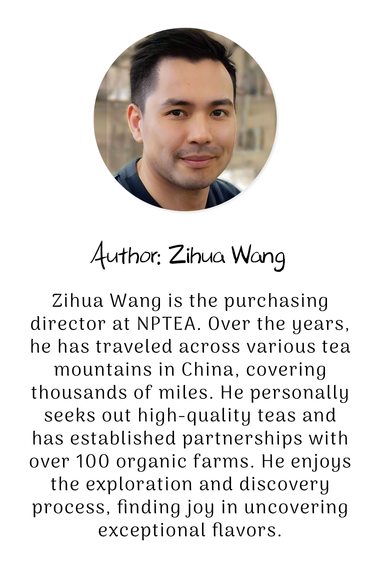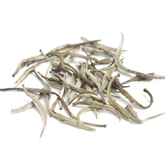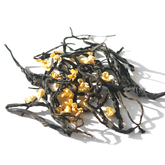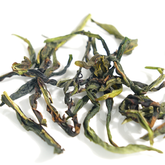The Difference Between Herbal Tea and the Six Types of Chinese Tea
In our daily lives, we often call anything brewed in hot water “tea” — whether it’s a cup of chamomile, peppermint tea, or a pot of Longjing or Pu-erh.However, not every drink we call “tea” actually comes from the true tea plant (Camellia sinensis). In fact, your favorite peppermint tea, chamomile tea, or fruit tea are, botanically speaking, not real tea at all.The core difference is simple yet fundamental:
All real teas (such as green tea, black tea, and oolong tea) come from the same plant species, Camellia sinensis, while herbal teas are made from an entirely different and diverse world of plants.
This article will help you clearly understand the key differences between herbal tea and the six main types of Chinese tea, from their origins, processing, composition, health benefits, and brewing methods. You’ll also discover why some teas keep you awake while others help you sleep — and why their brewing methods differ so much.
What Is “Real Tea”?
To understand what counts as real tea, we must first recognize one key fact:
China’s six types of tea are all made from the young buds and leaves of the tea plant (Camellia sinensis), processed in different ways and at different fermentation levels. These six categories are: green tea, white tea, yellow tea, oolong tea, black tea, and dark tea (hei cha).
Origin of the True Tea Plant
Botanical Identity:
The only source of all true teas is the tea plant — Camellia sinensis, a member of the Camellia family.
Extensive botanical, genetic, and archaeological research confirms that the tea plant originated and was first domesticated in Yunnan, Southwest China.Even today, ancient wild tea trees that are thousands of years old still grow in that region — living evidence that tea was born in China.
No matter its color, flavor, or aroma, as long as a tea comes from Camellia sinensis, it is a true tea.Just like all wines — whether red or white — come from grapes, all real teas come from the same tea plant.
Classification of the Six Tea Types
So why do teas from the same plant taste so different?The answer lies in the processing methods, especially the level of tea oxidation (often referred to as fermentation).
By adjusting the oxidation level through different traditional techniques, Chinese tea masters can create an astonishing diversity of teas — all from the same leaf.
What Is Herbal Tea?
Herbal tea (also known as flower tea or botanical tea) technically does not belong to the true tea family.
Unlike green tea, black tea, or oolong tea, herbal teas are not made from Camellia sinensis, but from various other plants — flowers, leaves, roots, fruits, or seeds.
Ingredients: Edible Plants
Herbal tea is brewed from edible plants other than tea leaves, using their dried and crushed parts such as roots, stems, leaves, flowers, fruits, or seeds.They are infused in hot water to extract aroma and beneficial compounds.
Common Types of Herbal Tea
Familiar examples include chrysanthemum tea, rose tea, peppermint tea, hibiscus tea, and chamomile tea.
Herbal teas can be single-ingredient (like pure chamomile tea) or blended, combining multiple herbs, fruits, and spices for complex flavor and function.
The Core Difference Between Herbal Tea and Real Tea
While both are called “tea,” herbal teas and the six major Chinese tea types differ fundamentally in origin, processing, chemical composition, health effects, and cultural background.
All real tea comes from the tea plant, naturally containing caffeine, which helps keep you alert.Herbal tea, however, is simply “a plant-based drink brewed like tea” — but without caffeine.
The six types of Chinese tea (green, yellow, white, oolong, black, and dark) all come from Camellia sinensis.Their distinct flavors and colors arise from differences in fermentation and processing.
In contrast, herbal teas come from many non-tea plants — such as roses, chrysanthemums, peppermint, lemongrass, hibiscus, apple, or even bark and roots like cinnamon and ginger.
Ingredient Differences Between Herbal Tea and Tea
All true teas — including green, black, and oolong — share three key active compounds:
-
Caffeine – stimulates alertness and focus.
-
Tea polyphenols (catechins) – powerful natural antioxidants that fight free radicals and slow aging.
-
L-theanine – a calming amino acid that promotes relaxation while balancing caffeine’s stimulation, creating a state of “calm alertness.”
Herbal teas, on the other hand, vary widely in composition depending on their plant source:
-
Peppermint contains menthol for a cooling sensation.
-
Chamomile contains apigenin, a compound that binds to brain receptors promoting relaxation.
-
Ginger contains gingerols that warm the body and aid digestion.
-
Rooibos (South African red bush) contains aspalathin, a unique antioxidant.
The most essential difference: herbal tea contains no caffeine, so it won’t disturb sleep or provide stimulation — the most fundamental distinction between the two.
Flavor and Sensory Differences
Drinking Chinese Tea
Because Chinese teas contain both caffeine and L-theanine, they lift your mind and focus while keeping you calm — ideal for working, studying, or creative thinking.
Tea drinking has long been part of Chinese life and culture.In China, it’s common to offer tea when hosting guests, and families often enjoy tea before or after meals.For many, tea is not just a drink but a lifestyle.
Drinking Herbal Tea
Drinking herbal tea provides a more direct and physical sensation — depending entirely on the plant used.
A cup of chamomile or lavender tea can ease the nerves and prepare the body for sleep.Peppermint or ginger tea can freshen the breath, warm the body, and aid digestion.
Unlike true tea, herbal teas do not offer mental stimulation but instead soothe specific parts or functions of the body.
Common Misunderstandings About Tea
❌ Misconception 1: “All teas contain caffeine.”
All true teas — green, black, oolong — do contain caffeine because they come from the tea plant.
However, herbal teas are made from non-tea plants like chamomile, peppermint, or rose, so most herbal teas are caffeine-free.
👉 For those sensitive to caffeine, including pregnant women or children, herbal teas are a gentle alternative.
❌ Misconception 2: “Flower tea = Herbal tea.”
This is a common mistake. According to Chinese tea classification, flower tea is still made from Camellia sinensis as the base.
For example, jasmine tea is a green tea scented with jasmine flowers — it’s a reprocessed tea, not a caffeine-free herbal infusion.Similarly, osmanthus black tea combines black tea with osmanthus flowers, and since its base is black tea, it also contains caffeine.
❌ Misconception 3: “Herbal tea is always healthier.”
While herbal teas are rich in essential oils and antioxidants, they are not universally beneficial.
Certain herbs (like licorice or peppermint) may interact with medications or cause mild discomfort in specific individuals.
Pregnant women, for instance, should avoid stimulating herbs such as peppermint or cinnamon.
By contrast, the six types of Chinese tea (green, white, oolong, black, yellow, dark) have been thoroughly studied. Their tea polyphenols and amino acids have proven health benefits — antioxidant, cardiovascular protection, and metabolism regulation.
In southern China, even pregnant women may drink mild tea daily without issues.
❌ Misconception 4: “Herbal tea is always gentle and non-irritating.”
Not always. Some potent herbs can irritate the stomach if consumed on an empty stomach.
For example, strong ginger tea may cause stomach burning, and peppermint tea can relax the esophageal sphincter, leading to acid reflux.
Like with Chinese loose leaf tea, NPTEA recommends avoiding tea on an empty stomach, as tea polyphenols and certain plant acids can irritate the digestive system.
Summary: Differences Between Herbal Tea and the Chinese Tea
First, their origins are fundamentally different — the six Chinese tea types all come from the tea plant, while herbal teas are made from a wide variety of other plants.
Second, composition differs: all real teas contain caffeine, polyphenols, and L-theanine, producing a balanced energizing effect.Herbal teas, however, vary based on ingredients and contain no caffeine.
Finally, the health benefits of the six Chinese tea types have been widely studied — from antioxidation to cardiovascular support and metabolic regulation.
Herbal teas’ effects, on the other hand, rely more on traditional and empirical use. Some may offer real therapeutic value, while others may trigger allergic or medicinal interactions.
SEE MORE ABOUT TEA
If you are a beginner about Chinese tea:
Basic-Guide-to-Chinese-Tea
If you have questions about selecting tea:
Learn-more-about-chinese-tea
If you have questions about the benefits of tea:
Health-benefits-of-chinese-tea
If you have questions about brewing tea:
How-to-brew-loose-leaf-tea






